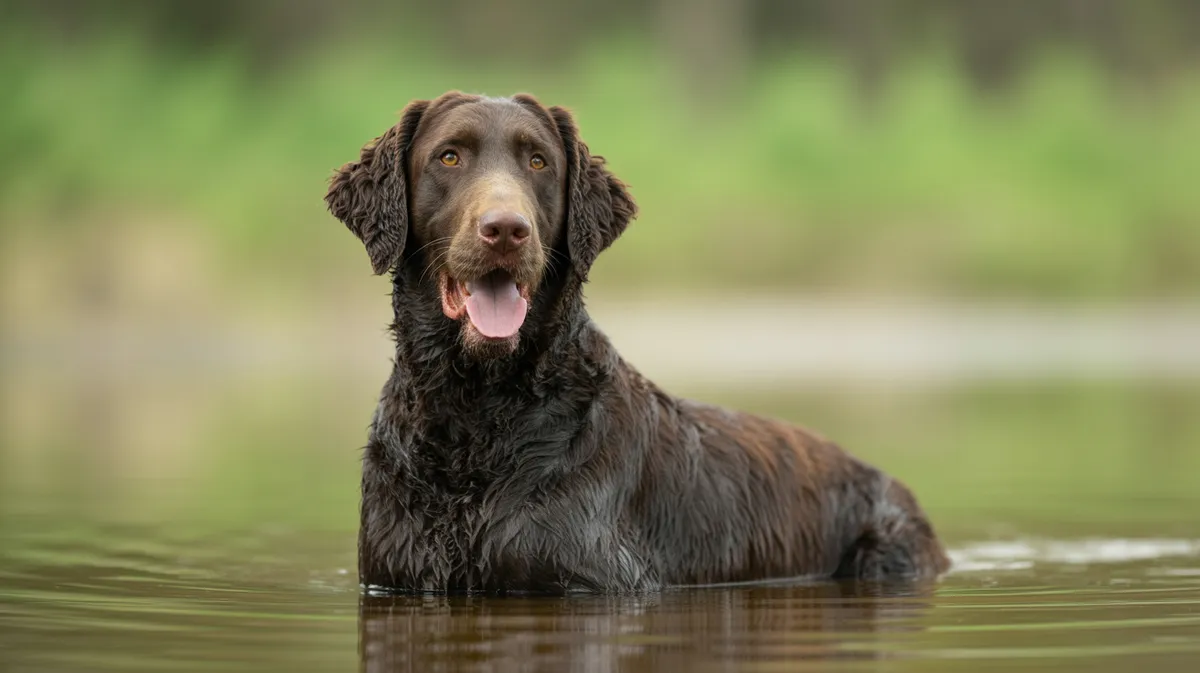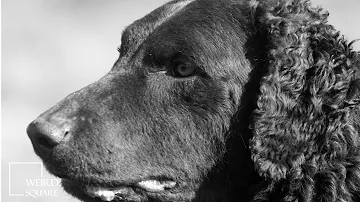
Curly-Coated Retriever
Canis lupus familiaris

Meet the Curly-Coated Retriever
The Curly-Coated Retriever is a distinctive and versatile breed known for its tight, water-resistant curls and remarkable retrieving abilities. Developed in England in the 19th century, it is one of the oldest retriever breeds and is especially valued for its stamina, intelligence, and adaptability in both land and water. This breed excels in hunting, companionship, and canine sports, and is recognized for its friendly but independent temperament. Its unique coat provides excellent protection against cold and wet conditions, making it an excellent working dog in challenging environments.
Classification
Mammal
Habitat
Domestic; often found near wetlands, lakes, rivers, and forests where hunting and retrieving are practiced
Diet
Omnivore
Lifespan
10-12 years
Conservation
Least Concern
Weight
60-95 lbs (27-43 kg)
📖Fascinating Facts
Unique Curls
The breed’s tightly curled coat repels water and protects against harsh weather, making it ideal for retrieving in cold, wet environments.
Skilled Hunter
Curly-Coated Retrievers were bred for retrieving game from both land and water, and are known for their stamina and effectiveness in the field.
Loyal Companions
While friendly and devoted to their families, Curlies have an independent streak and are often less overtly affectionate than other retrievers.
📋Detailed Description
The Curly-Coated Retriever is a large, athletic gundog, typically standing 63–69 cm (25–27 in) at the withers and weighing between 27–36 kg (60–80 lbs). Its most distinctive feature is the dense, crisp, water-resistant coat of tight curls covering the body, which provides exceptional insulation and protection against harsh weather and cold water. The head is long and wedge-shaped with a relatively shallow stop, and the ears are small, set close to the head, and also covered in curls. The breed possesses a deep chest, strong limbs, and a level topline, all contributing to its stamina and agility in the field. Curly-Coated Retrievers are known for their intelligence, independence, and versatility, excelling in both upland and waterfowl retrieval. They are generally friendly and affectionate with family members but may be reserved with strangers, reflecting their history as both working and companion animals. Their keen sense of smell and soft mouth make them highly effective in retrieving game without damage. The breed is also noted for its high energy levels, requiring regular exercise and mental stimulation. Lifespan typically ranges from 10 to 12 years, with some individuals living longer with proper care.
💡 Did you know?
The Curly-Coated Retriever is one of the oldest retriever breeds and was shown at England's very first dog show in 1860.
🔬Research & Sources
Wikipedia Summary
The Curly-coated Retriever is a breed of dog originally bred in England for upland bird and waterfowl hunting. It is the tallest of the retrievers and is easily distinguishable by the mass of tight curls covering its body. Curly Coated and Wavy Coated were the first two recognised retriever breeds, established as early as 1860.
Last Modified: 11/7/2024
🎭Behavior & Social Structure
Curly-Coated Retrievers are energetic, intelligent, and independent, often displaying a confident and self-reliant demeanor. In the field, they are methodical and persistent, using their acute sense of smell and memory to locate and retrieve game over challenging terrain and through water. They are strong swimmers, often plunging enthusiastically into cold or rough water. At home, Curlies are generally calm and affectionate, though they retain a playful streak well into adulthood. Socially, they tend to bond closely with their families but may be aloof or cautious around unfamiliar people, making early socialization important. They are known for their problem-solving abilities and can become bored or mischievous if not given sufficient mental and physical activity. Daily routines should include vigorous exercise, such as running, swimming, or retrieving games, to satisfy their working instincts.
👶Reproduction & Life Cycle
Curly-Coated Retrievers are typically sexually mature by 12–18 months, with females coming into estrus (heat) twice a year. The breed does not have a defined breeding season, as is typical for domestic dogs. Mating is usually managed by breeders to ensure genetic diversity and health. Gestation lasts approximately 63 days. Litter sizes average 6–9 puppies, though larger litters are not uncommon. The dam provides primary care, nursing and cleaning the puppies, with weaning beginning around 3–4 weeks and completion by 6–8 weeks. Responsible breeders screen for hereditary conditions such as hip dysplasia and eye disorders to maintain breed health.
🛡️Adaptations & Survival
The Curly-Coated Retriever’s most notable adaptation is its unique coat, composed of tight, water-repellent curls that protect against cold, wet, and abrasive environments. This coat evolved to enable the breed to work efficiently in icy water and dense underbrush. Their webbed feet and muscular, streamlined bodies enhance swimming ability and endurance. Behaviorally, their independence and intelligence allow them to work at a distance from handlers, making decisions in the field. Their soft mouth is an adaptation for retrieving game without causing damage, a trait reinforced through selective breeding.
📚Research Sources
🎨Cultural Significance
The Curly-Coated Retriever holds a special place in British sporting history as one of the earliest standardized retriever breeds, recognized as early as the 1860s. It was highly valued by gamekeepers and hunters for its versatility and resilience. The breed has appeared in literature and art as a symbol of the classic British gundog. While less common than other retrievers today, the Curly continues to be celebrated in field trials, dog shows, and as a loyal companion. Its distinctive appearance and working heritage have made it a subject of interest among canine historians and enthusiasts.
🔬Recent Research & Discoveries
Recent genetic studies have explored the origins of the Curly-Coated Retriever, confirming its close relationship to other retriever breeds and identifying unique genetic markers associated with its curly coat. Ongoing research focuses on breed-specific health issues, particularly cancer prevalence and immune system function. Studies on canine cognition have highlighted the Curly’s problem-solving abilities and independent working style. Conservation of genetic diversity within the breed is a current priority among breed clubs and researchers, with international cooperation to maintain healthy populations.
🎥Wildlife Videos

Facts about Curly Coated Retriever originally developed as a gun dog
The Curly Coated Retriever was originally developed as a gun dog and their temperament and conformation reflect this purpose.
Animal Square

Curly Coated Retriever Breed Profile History - Price - Traits - Curly Grooming Needs - Lifespan
In this video we have covered these topics in details : Curly Coated Retriever Breed Profile Curly Coated Retriever History Curly ...
Animal Platoon

Curly Coated Retriever - AKC Dog Breed Series
Learn more about Curly Coated Retriever http://www.akc.org/dog-breeds/curly-coated-retriever/
American Kennel Club

Curly Coated Retriever Pros and Cons | Curly Coated Retriever Advantages and Disadvantages
Topics Covered: Curly Coated Retriever Pros and Cons Curly Coated Retriever Advantages and Disadvantages Watch This ...
Animal Platoon

Curly Coated Canines | Unraveling the Mystery #shorts #animals #viral
Curly Coated Canines | Unraveling the Mystery #shorts #animals #viral Welcome to Pet City Zoo! Your one-stop shop for all things ...
Pet City Zoo

Wyoming, Sharptails, Huns, Pheasants/Curly Coated Retriever Part 1
Have you ever wanted a trifecta of sorts? This is a hunting trip for three different species of gamebirds. We are in Wyoming—a ...
Bird Dogs Forever
🌍Habitat Information
The Curly-Coated Retriever typically inhabits Domestic; often found near wetlands, lakes, rivers, and forests where hunting and retrieving are practiced environments. Curly-Coated Retrievers have adapted to their environments with specialized features and behaviors.
Primary Habitat:
Domestic; often found near wetlands, lakes, rivers, and forests where hunting and retrieving are practiced
More detailed habitat information will be available soon.
🛡️Conservation Status
The Curly-Coated Retriever is currently classified as Least Concern. Conservation efforts are crucial for preserving this species for future generations.
Common Threats:
- 🏠Habitat loss and fragmentation
- 🌡️Climate change impacts
- 🎯Hunting and poaching
- 🏭Human-wildlife conflict
⚠️Threats & Conservation Challenges
As a domestic breed, the Curly-Coated Retriever is not threatened in the wild, but it faces challenges related to population size and genetic diversity. It is considered a relatively rare breed, with limited numbers registered annually worldwide. Health concerns include a predisposition to certain hereditary conditions such as hip dysplasia, progressive retinal atrophy, and some cancers. Responsible breeding practices and health screening are essential to maintain the breed’s vitality. Popularity fluctuations and competition from other retriever breeds can also impact breeding programs and genetic diversity.
🔬Scientific Classification
Scientific Name
Canis lupus familiaris
Classification Hierarchy
🔍 About Taxonomic Classification
Taxonomic classification is a hierarchical system used by scientists to classify and organize living organisms based on shared characteristics and evolutionary relationships.
The system moves from broad categories (Kingdom) to increasingly specific ones, with each animal's scientific name typically consisting of its Genus and species.
📝Community Notes
Share your observations and insights about the Curly-Coated Retriever with our community of wildlife enthusiasts.
Join Our Community
Sign in to share your observations and connect with fellow wildlife enthusiasts.
Sign In to ContributeNo community notes yet
Be the first to share your observations about the Curly-Coated Retriever!
Explore Curly-Coated Retriever
Select a tab above to learn more about this amazing animal.
📸Photo Gallery
No photos available for this animal yet.
🌟Discover More Wildlife
Continue your journey of discovery with more fascinating animals from our database
